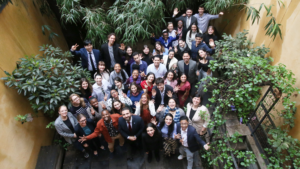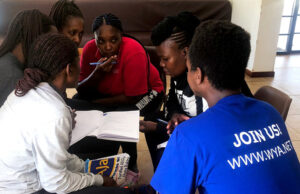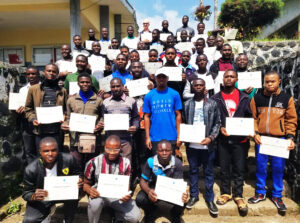[su_tabs active=”2″][su_tab title=”English”]
Culture is one expression of our shared value as people. Art is a very important part of culture and dance is a very important part of art. Through different dances, like ballet, one transmits their emotions and point of view. The Certified Training Program explains how art is a very effective way to promote a political ideology and it cautions us since it can be a tool to manipulate us. One has to learn how to identify when art is being used as a weapon and learn to use art to empower the dignity of the person instead.

The CTP is offered by the World Youth Alliance in order to allow people to learn more about human dignity through various concepts such as freedom, solidarity, and culture, among others. This program delves into human dignity and explains how everyone should be able to use art as a form of its empowerment.
A good example of how this was done was by Michaela DePrince. She was a war orphan from Sierra Leone who broke barriers when she became a star ballerina. She is not only a ballerina soloist, but she has also written a book and will be starring in a movie.
Black and colored ballerinas have long struggled as the minority, largely excluded from this art form. They have always been demotivated to participate. Ballerinas have white, tan, or pink tights, leotards, and shoes to match their skin tone in order to avoid “breaking the line” that they make with their bodies while dancing. Choreographers want uniformity in their ballerinas’ costumes and therefore force black and colored performers to wear material that isn’t their skin color, as if they were trying to change themselves, which makes them feel extremely excluded and out of place.
After 200 years of there being white and pink ballerina shoes, there are a small amount of stores that sell black and gold ones but this isn’t enough. These stores have to be available everywhere and with more shoe colors. Before this, performers had to paint their shoes by hand or spray paint them. This takes them 40 minutes to do and they have to repaint them every day. Also, these shoes don’t last long since the paint damages them extremely.
It would have been incredibly easy to make these shoes in different colors, like how one does with T-shirts, but it was decided against. This is just one example of the importance of raising awareness about the dignity of the human person and the many ways we must improve in our culture to embrace the inherent diversity of humanity. Absolutely everyone has dignity because of the fact that they are human. No one can take that away from anyone. Programs like the CTP talk about human dignity, culture, art, and how they affect each other. It is crucial to understand these topics better in order to advocate for them.
[su_divider top=”no” size=”1″]
Published: July 16, 2020
Written by Paula Bernasconi Vargas, intern alumni from the WYA Latin America Office
References:
Marshall, A. (2018). Brown point shoes arrive, 200 years after white ones.
Nationale Opera & Ballet. (2020). Michaela Deprince.
[/su_tab]
[su_tab title=”Spanish”]
La cultura es una expresión de nuestro valor compartido como personas. El arte es una parte muy importante de la cultura y la danza es una parte muy importante del arte. A través de los diferentes bailes, como el ballet, uno transmite sus emociones y su punto de vista. El Programa de Entrenamiento Certificado (CTP) explica cómo el arte es una forma muy efectiva de promover una ideología política y nos advierte, ya que puede ser una herramienta para manipularnos. Uno tiene que aprender a identificar cuándo se está utilizando el arte como arma y aprender a usar el arte para potenciar la dignidad de la persona.

La World Youth Alliance ofrece el CTP para permitir que las personas aprendan más sobre la dignidad humana a través de varios conceptos como libertad, solidaridad y cultura, entre otros. Este programa profundiza en la dignidad humana y explica cómo todos y todas deberían poder utilizar el arte como mecanismo de empoderamiento.
Un buen ejemplo de esto es como lo ha hecho Michaela DePrince. Ella fue una huérfana de guerra que rompió barreras al convertirse en una bailarina estrella. No solo es una bailarina solista, sino que también ha escrito un libro y protagonizará una película.
Las bailarinas negras y de color han luchado durante mucho tiempo como minoría, en gran medida, excluidas de esta forma de arte. Siempre han sido desmotivados para participar. Las bailarinas tienen medias, leotardos y zapatos blancos, tostados o rosados que combinan con su tono de piel para evitar “romper la línea” que hacen con sus cuerpos mientras bailan. Los coreógrafos quieren uniformidad en el vestuario de sus bailarinas y, por lo tanto, obligan a los y las artistas negros y de color a usar material que no sea su color de piel, como si estuvieran tratando de cambiarse, lo que los hace sentir extremadamente excluidos y fuera de lugar.
Después de 200 años de haber zapatos de bailarina para personas blancas, comienza a haber una pequeña cantidad de tiendas que venden zapatos negros y dorados, pero esto no es suficiente. Estas tiendas deben estar disponibles en todas partes y con más colores de zapatos. Antes de esto, los artistas tenían que pintar sus zapatos a mano o rociarlos. Esto les lleva 40 minutos y deben volver a pintarlos todos los días. Además, estos zapatos no duran mucho ya que la pintura los daña extremadamente.
Hubiera sido increíblemente fácil hacer estos zapatos en diferentes colores, como se hace con las playeras, pero se decidió no hacerlo. Este es solo un ejemplo de la importancia de crear conciencia sobre la dignidad de la persona y las muchas formas en que debemos mejorar nuestra cultura para abrazar la diversidad inherente de la humanidad. Absolutamente todos y todas tienen dignidad por el simple hecho de que son humanos. Eso nunca se puede quitar. Programas como el CTP hablan sobre la dignidad humana, la cultura, el arte y cómo se afectan mutuamente. Es crucial comprender mejor estos temas para abogar por ellos.
[su_divider top=”no” size=”1″]
Publicado: 16 de julio de 2020
Escrito por Paula Bernasconi Vargas, alumna interna de la Oficina de América Latina de la WYA.
Referencias:
Marshall, A. (2018). Llegan los zapatos de punta marrón, 200 años después de los blancos.
Nationale Opera & Ballet. (2020). Michaela Deprince.
[/su_tab] [/su_tabs]







